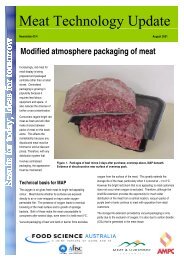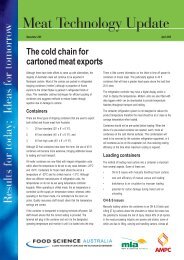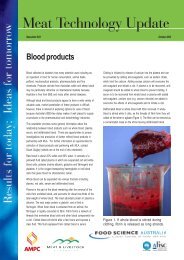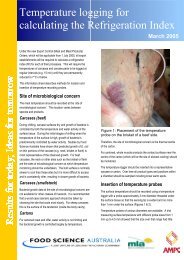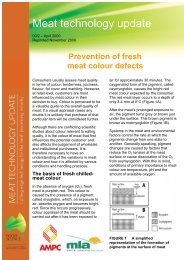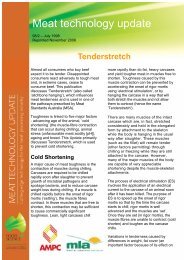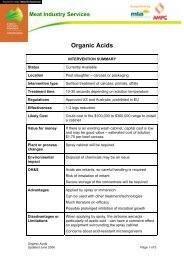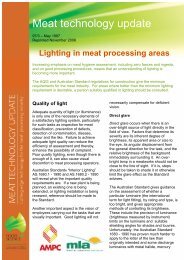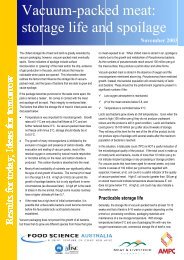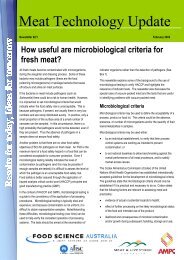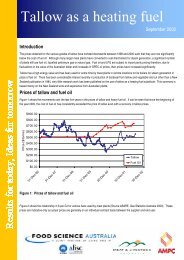Understanding Meat Yield - Red Meat Innovation
Understanding Meat Yield - Red Meat Innovation
Understanding Meat Yield - Red Meat Innovation
You also want an ePaper? Increase the reach of your titles
YUMPU automatically turns print PDFs into web optimized ePapers that Google loves.
deposition of fat continues.It is possible to indirectly estimate the proportion of muscle in acarcase by estimating its overall fatness. The measurement of fatdepth has, as a consequence, become an important component ofcarcase classification schemes for beef, sheep and pork carcases,worldwide.There are major fat depots within the carcase. The first to bedeposited is the internal fat (kidney and channel fat), whichrepresents about 4% of the carcase weight. The ‘intermediate’ sitesof deposition are beneath the skin (subcutaneous fat) and betweenthe muscles (intermuscular fat). The remaining site of fat depositionis within the muscle (marbling). Marbling was thought to develop ata later age but this has recently been refuted. Fat deposition occurssimultaneously within the depots but at different rates depending onthe age of the animal.Carcase weightCarcase weight has a major influence, not only on the quantity ofthe various tissues, but also on the size of the individual muscleswithin the primal cuts. carcase weight is important, as therelationship between carcase weight and fatness varies betweenbreeds and also between grass and grain-fed animals.Furthermore, the individual weights of various muscles and primalcuts are highly related to the total weight of the carcase so anunderstanding of this relationship is important when attempting tomeet market specifications with regard to primal-cut weight.Muscle-to-bone ratioAfter accounting for weight and fatness, the remaining variation incarcase composition in mixed breed populations is largely explainedby differences in muscle: bone ratio. It is an important characteristicof any carcase in determining its ultimate value and, clearly, thehigher the muscle:bone ratio, the better the yield. The muscle:boneratio changes during growth and plateaus near its maximum value(around 5.1, 4.8 and 4.9 for bulls, steers and heifers, respectively)when animals reach about 50% of their mature weight. If animalsare slaughtered beyond 50% maturity, there is little need to considergrowth changes in this ratio. However, if an animal is slaughteredearlier than this, when its overall weight and proportion of muscleare both increasing, the weight of saleable meat and, therefore, thevalue of the carcase, will increase appreciably after small timeintervals (i.e. weeks). While this has remained an important criterionwhen assessing yield, the accurate estimation of the muscle:boneratio by means other than complete dissection of the carcase intocomponent parts, has remained elusive. Subjective assessments ofmuscle score (i.e. degree of muscling) have been used with varyingdegrees of success in live animal and carcase-classificationsystems as a proxy for muscle:bone ratio; however, such scores arestill constrained by the vagaries of subjective assessment.Production factors that influence yieldCarcase composition can be controlled, within limits, by modifyingthe factors that influence the growth of different tissues. Muscle isthe most desired tissue, bone is the least desired and fat is desiredin different amounts by different markets and consumers.The production variables that control fatness are breed, live weight(and maturity) at slaughter, sex, and nutrition. Growth promotantsare a recent short-term method for controlling fatness. They areused in approximately 90% of US lot-fed cattle and reasonablywidely throughout Australia. The most important determinantproducers will use when deciding how to manipulate carcasefatness will always be economic. The returns for producing leanerstock must be financially worthwhile to both producers andprocessors for it to occur.BreedThe genotype of the animal determines the potential for it todevelop particular carcase characteristics and meat quality.Genetic differences in yield and fatness traits have been observedbetween breeds and between strains within breeds.No single cattle breed has all the attributes that are needed toproduce beef efficiently in all environments, and to meet therequirements of all markets. The appropriate use of systematiccrossbreeding programs provides significant benefits to the beefindustry in terms of both yield and meat quality. Similar programsbenefit the sheepmeat industry.Carcase composition traits such as fat thickness and carcaseweight are moderately to highly heritable and breeding programsrespond well to genetic selection. Most estimates of beef andsheepmeat yield percentage are also moderately to highlyheritable. Therefore, producers can exploit the genetic variationthat exists to make rapid genetic gains in saleable meat yield.The table below indicates the results for carcase attributes frompurebred steers produced in the Germplasm Utilisation Program atthe US <strong>Meat</strong> Animal Research Center, Clay Center, Nebraska.BreedBritishCarcasewt (kg)Fat depth*(mm)Fat trim(%)SMY (%)<strong>Red</strong> Poll 315 7.62 22.4 62.6Hereford 306 11.68 25.5 60.1Angus 316 11.68 24.4 61.5EuropeanLimousin 330 4.32 13.4 72.3Simmental 348 4.06 15.5 68.4Charolais 348 3.56 15.0 68.7* Fat thickness 12/13 th rib (Adapted from Cundiff and Gregory, 1999)European breeds excelled in saleable meat yield but had difficultygrading USDA Choice because of lower levels of marbling. Britishbreeds excelled in USDA carcase-quality grade but had excessivefat thickness and percentage fat trim and reduced saleable meatyields.



